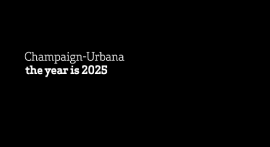by Steve Sonka, Interim Vice Chancellor for Public Engagement, University of Illinois at Urbana-Champaign
(This article appears in the July, 2010 issue of The ACUPCC Implementer)
As we undertook to develop an ambitious, yet realistic action plan, theUniversity of Illinois at Urbana-Champaign faced a dilemma common to many universities: how to commit to goals based on predictions of conditions 20, 30 or even 40 years in the future. Further complicating efforts, our proposal dealt with issues involving building efficiency, renewable energy sources, and technologies that haven’t been invented yet, all while bearing in mind public sector budget deficits and the current reality of financial stress across campus. Our careful planning also had to take into consideration the size and diversity of our Big Ten campus, comprising some 41,000 students, 3,000 faculty, and more than 700 buildings. Acknowledging these challenges, the project team of students, staff and faculty working on the climate action plan also had to accept the certainty that new research on environmental issues will surely mean future adaptations to an already complicated plan.
With this flexibility in mind, we set out to develop a meaningful climate action plan, called iCAP, which incorporated aggressive “stretch targets”. In so doing, the project team adopted implicitly the framework ofstrategic intent, as described in an article of the same name by Gary Hamel and C.K. Prahalad. The corporate sector often uses strategic intent to describe companies that have risen to global prominence by envisioning a desired leadership position and establishing the criterion the organization will use to chart its progress. The companies focus their attention on the essence of winning and motivate their employees by communicating the value of the target. In our case, the iCAP strategic intent describes the University’s unique ambitions and provides a guide to allocating resources and setting agendas. This strategic intent lends consistency to short-term actions and, in the future, it will allow room for reinterpretation as new technologies, opportunities, and challenges emerge.
Beyond Current Obstacles: Focusing on the Future’s Opportunities
The strategic intent framework encourages contributors to put dreams on paper and begin implementing change instead of using the unknown as an excuse for inaction. To help the campus community envision goals of becoming healthier, cleaner, safer and more prosperous, one iCAP contributor, Assistant Professor Brian Deal led in authoring a creative letter from the perspective of a future chancellor in the year 2050. The letter helped iCAP collaborators put aside current obstacles—budget, technology, resources—and focus on the future’s opportunities, even without knowing every step along the way. The letter predicted the University’s position as a “global leader in education and research” based on “brave decisions” made in 2010.
Indeed, the iCAP goals exemplify ambition: elimination of coal combustion by 2017, a reduction in building energy use of 40 percent by 2025, and carbon neutrality by 2050. The plan limits facility growth, incorporates aggressive building energy conservation plans, and calls for the de-carbonization of energy generation systems along with changes to transportation, food and agricultural systems and large-scale renewable energy sources. Illinois is proud to be the first Big Ten University to have met the commitment, especially to have met it with a strong plan, but it wasn’t easy to engage and satisfy constituencies, including skeptical administrators. It is our hope that campuses across the country can produce similar achievable, affordable, and implementable plans.
We know because we already have seen positive changes on our campus; total energy consumed by the campus dropped 6.5 percent in fiscal year 2009 compared to fiscal year 2008. These changes reflect a broadening campus conservation effort, including retrocommissioning of several large buildings, departmental and college reduction initiatives, reduced HVAC system operating hours, and a campus relamping program. Fiscal year 2009 was only the second time in 20 years that campus electricity consumption dropped from one year to the next.
We believe that continuing to achieve results like these and to reach iCAP benchmarks will sustain enthusiasm and inspire our diverse faculty, staff, and student body to actively defend iCAP because they see reflections of their contributions in the rewards. Now that we have finished the plan, we can focus our attention and resources on the essence of our vision: a cleaner, brighter, more energy-efficient campus. But expressing the strategic intent is only the first of several difficult but rewarding steps needed to achieve that vision. Those steps will require an active management process that includes motivating our staff and students by communicating the value of our vision; ensuring that administrators hear campus voices and, if relevant, act upon those contributions by changing the way the campus operates; and using our vision of the campus to guide resource allocations without fail.


Add new comment